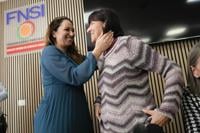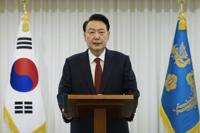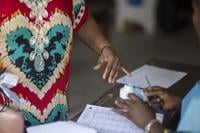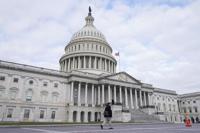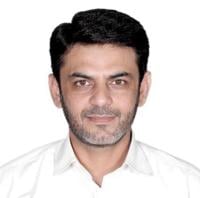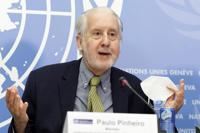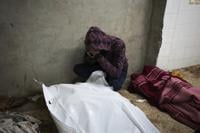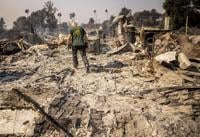ROME (AP) — One of the first women who accused a once-exalted Jesuit artist of spiritual, psychological and sexual abuse went public Wednesday to demand transparency from the Vatican and a full accounting of the hierarchs who covered for him for 30 years.
Gloria Branciani, 59, appeared at a news conference with one of the most prominent Vatican-accredited lawyers in Rome, Laura Sgro, to tell her story in public for the first time. She detailed the alleged abuses of the Rev. Marko Rupnik, including his fondness for three-way sex “in the image of the Trinity” which, if confirmed, could constitute a grave perversion of Catholic doctrine known as false mysticism.
Rupnik has not commented publicly about the allegations, but his Rome art studio has said the and media reports about the case a defamatory “lynching.”
Rupnik’s mosaics decorate churches and basilicas around the world, including at the Catholic shrine in Lourdes, France, the forthcoming cathedral in Aparecida, Brazil, and the Redemptoris Mater chapel of the Apostolic Palace.
The Jesuits last year after he refused to respond to allegations of spiritual, psychological and sexual abuses by about 20 women, most of whom, like Branciani, were members of a Jesuit-inspired religious community he co-founded in his native Slovenia that has since been suppressed.
The Rupnik scandal has grabbed headlines for more than a year over speculation that he received dominated by Jesuits: From Pope Francis to the Jesuits who headed the Vatican office responsible for sex crimes and sacramental crimes that twice essentially let him off the hook.
Under pressure as the scandal grew, Francis in October and Branciani is due to soon testify before the Dicastery for the Doctrine of the Faith. Sgro said that she didn’t know what the possible lines of investigation are since the Dicastery’s proceedings
Branciani, who first denounced Rupnik in 1993 and then left the Slovene community, called for the full story of the Rupnik scandal and cover-up to come out in public, including the documentation. She said that she believed that the pope was still in the dark about the details and that even he would be served by the truth.
“He (Rupnik) was always protected by everyone, and everything that you could accuse him of was either minimized or denied,” she said. “We hope that our testimony ... will stimulate a greater transparency and a consciousness by everyone, and also maybe the pope, who wasn’t really aware of the facts that occurred.”
Francis, , said he had intervened in the case only on procedural grounds and didn't know the details.
Rupnik’s former Jesuit superior, the Rev. Johan Verschueren, said he had no contact for a lawyer for Rupnik. There was no immediate response to an email seeking comment from his Centro Aletti art studio and ecumenical center in Rome, which has strongly defended him. The Koper, Slovenia diocese, which welcomed Rupnik after he was expelled from the Jesuits, referred to an October statement saying he hadn't been convicted by any tribunal and was presumed innocent.
The Vatican press office offered an update on the investigation after Branciani’s press conference, saying the Dicastery for the Doctrine of the Faith had “just received the latest elements” of documentation from several institutions, including some not previously heard from.
“It will now be a matter of studying the documentation acquired in order to be able to identify what procedures will be possible and useful to implement,” the statement said.
In the news conference, Branciani described a textbook case of manipulation of conscience, sexual abuse and false mysticism, which the doctrine office has a tradition of prosecuting. After saying she underwent years of psychological manipulation, grooming and sexual advances, including while Rupnik painted the face of Jesus, she said she eventually lost her virginity to him.
At one point, she said that according to Rupnik, “Our relationship wasn’t exclusive but had to be a relation in the image of the Trinity.”
“And so as proof that our relations were truly in freedom, we had to invite another sister to live sexually with us because this sister would have had the significance of the third person of the Trinity, the Holy Spirit who united our way of relating with one another. And he even proposed the name of the sister,” she said.
The Vatican dicastery handles crimes of sexual abuse of minors as well as sacramental crimes. In the 1950s, it sanctioned a French Dominican priest, the Rev. Thomas Philippe, for false mysticism and other crimes after he to justify his abuse of women by claiming that Jesus and Mary were involved in incestuous sexual relationships.
The office actually took the first, and only, Vatican action against Rupnik in 2020, when it declared him excommunicated for having committed one of the most serious crimes in church law, using the confessional to absolve a woman with whom he had engaged in sexual relations.
The excommunication was lifted two weeks later and Rupnik paid an indemnization to the woman. The following year, after nine members of the Slovene community accused him of other abuses, the dicastery chose not to prosecute him on the grounds that the alleged abuses occurred too long ago. The office routinely waives the statute of limitations for old cases involving abuse of minors.
The outcome underscored how the Catholic hierarchy that must be punished, but rather a lapse of priestly chastity that can be forgiven, without considering the trauma it causes victims.
Branciani was joined at the press conference by another former member of the Slovene Loyola Community, Mirjam Kovac, who had served as a secretary to the community’s founder and had also reported the abuses.
The event was organized by BishopAccountability, a U.S. group that documents the abuse crisis. Its co-founder Anne Barrett-Doyle called for a full public accounting of the Rupnik cover-up along the lines of the 2020 Vatican report into the coverup of ex-Cardinal Theodore McCarrick, which documented bishops, cardinals and even popes who downplayed or dismissed his misconduct for decades.


